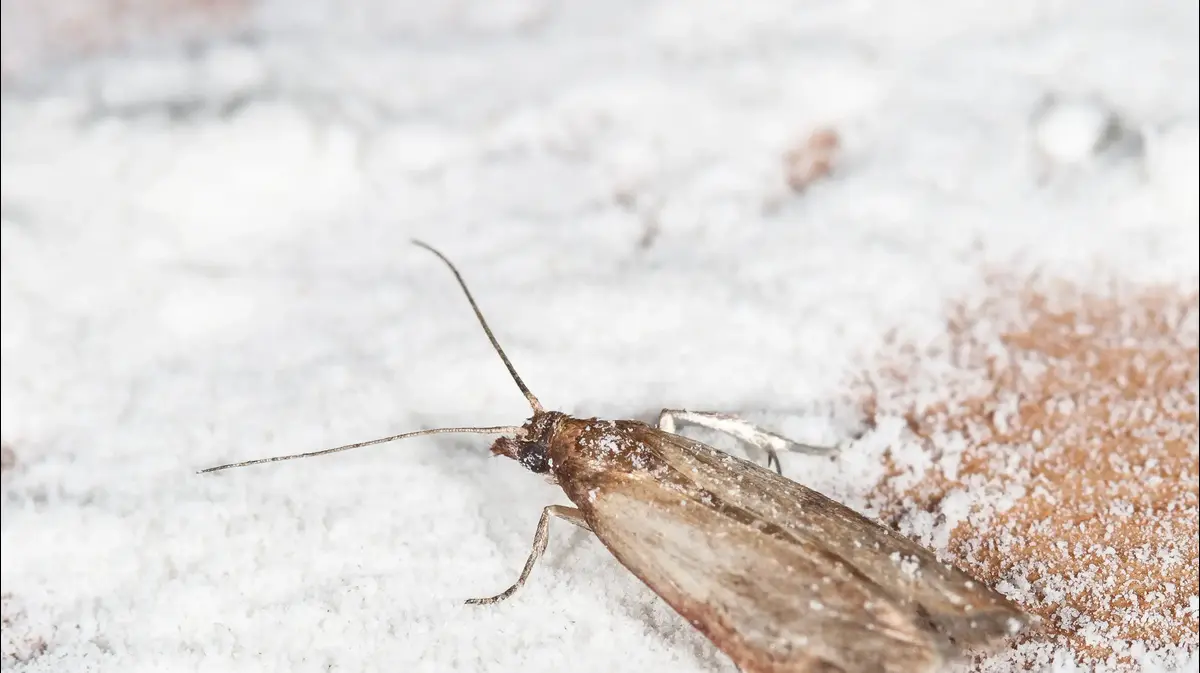This is how you will get rid of the act of food - which is why it is so common among you
Did you also notice them suddenly?
As with any beginning of summer, the food moth returned to frequent our kitchen and once again began this never-ending war against them.
Here are some ways to get rid of them - and why they come to our home in the first place
Not to be missed
04/07/2022
Monday, 04 July 2022, 23:43
Share on Facebook
Share on WhatsApp
Share on Twitter
Share on Email
Share on general
Comments
Comments
How can the food act be disposed of?
(TIKTOK)
After we got rid of flies, mosquitoes, cockroaches and rats - it was time to treat one of the most common blows of early summer - the food moth.
Has your home also recently been flooded with tiny gray moth butterflies fluttering unsteadily in the kitchen?
Did you spot some suspicious webs in your closet doors or box of cereal or even in spice jars?
You may be sharing your dry food with the food moth - and it's time to get rid of it too.
Who is the moth?
The moth is a tiny 10 mm-sized insect that is brownish-gray in color and belongs to the butterfly family. There are more than 120,000 species of moths in the world, but the ones we encounter at home are food moths and clothing moths, which are most common during the transition season. Dry and looking for open food packaging to lay its eggs in. These are usually unsealed packages of legumes or grains, such as pasta, rice and beans, in which we may find eggs and small butterflies that feed on the food. Their fondness for dry food makes them the main pest in food storage facilities
. They entered your home - and what can you do to get rid of them? Here's what the experts at The Conversation had to recommend to you.
More on Walla!
How do you get kids started recycling?
With the help of original tips and ideas
In collaboration with Tamir
Sorry but you are not welcome here.
Food moth (Photo: ShutterStock)
Like other species, food moths have four stages of life: egg, larva, pupa and adult.
The first sign of food moth infection is often the appearance of adult moth butterflies flying in an unstable zig-zag path throughout our kitchen.
However, their existence bothers us in the eye, adult moths do not feed at all.
The real trouble is when female moths lay their eggs in or around our food.
The tiny eggs hatch into cream-colored larvae that barely look and are small enough to crawl into food containers that are not sealed well enough, where they begin to eat.
As they grow, larvae produce large amounts of strips of silk and feces, both of which can contaminate food.
Once the larva reaches its full size, it leaves the food in search of a safe place to form a tuber, such as a crack in the wall, container lid, groove or corner.
Sometimes they appear in the hinges of the pantry door.
A few weeks later, an adult moth emerges from the tubercle, ready to begin this life cycle again.
The larvae are small and almost invisible (Photo: ShutterStock)
How did he get to us?
Unfortunately, you probably brought it home with you.
Although food moths can easily pass through doors and windows, most lesions are formed when we bring home without knowing at all moth eggs and larvae in our dry food.
Kitchens filled with unsealed containers and food spilled in drawers or pantry shelves are a temptation that the moth female is unable to resist in her search for the ideal place to lay her eggs.
Like many insects, food moths develop faster at warm temperatures.
In hot temperatures females also lay more eggs and larvae are more likely to survive to adulthood.
However, prolonged exposure to temperatures above 40 degrees Celsius is fatal to eggs and larvae.
While the food moth can be found at any time of the year, the hot temperatures of late spring and early summer are often perfect for supporting the rapid growth of this insect population.
Yes, right now.
So how do you get rid of them?
Eliminate their food sources.
We stored dry products in closed containers with tightly sealed lids.
Insects can penetrate through plastic boxes and fasteners designed to keep food fresh are not always effective in preventing moths.
2. It is difficult to see the food moth larvae.
Look for the silk strip they make, which can cause food grains to stick together.
These lumps are usually more prominent than the larvae themselves and will help you locate them.
3. To prevent eggs and larvae from climbing hitchhiking on our purchases, put dry food in the freezer for three to four days.
It is supposed to kill all the eggs and larvae that may be present there.
If you have already noticed the food moth in your kitchen, carefully examine all potential food sources including spices, grains, pet dry foods, pasta, seeds, nuts, tea, dried flowers and dried fruits.
4. The food moth thrives in a dirty environment.
Be sure to thoroughly clean the kitchen and pantry cabinets thoroughly.
Clean and discard any spilled food on shelves, under toasters or behind storage containers.
Even small amounts of food can support thriving larval populations.
Did you find suspicious webs on your dry food?
A sign that you have a moth at home (Photo: ShutterStock)
5. Larvae can travel considerable distances to find a safe place to prepare a tuber, so be sure to check shelves, walls, grooves and ceilings.
Moth tubers can be removed by wiping with a damp cloth or with a vacuum cleaner.
6. Throw in the trash.
Happens that cause food to unite into one lump and a strong odor of rot, are signs that your food is infected with moths.
Leaving food with eggs will cause the moth to reappear so any food you suspect may be contaminated should be thrown away.
7. Electric pesticide and spraying.
There are ultraviolet devices for exterminating flies, including moth butterflies.
These are lamps that connect to electricity and these electrify the insects and eliminate them.
You can also always turn to spraying - clear the kitchen cabinets, call an exterminator and leave the house for 5 hours.
When storing food in closets make sure you do not return food products that may be contaminated with eggs that will start the infection again.
8. Sticky food moth traps.
They can be used to monitor and reduce the moth population.
These traps are made of cardboard covered with thick glue, they attract moth butterflies with the help of a chemical that mimics the smell of the female food moth.
Males are attracted to the trap and cling to it.
Because sticky traps are only aimed at males, they are unlikely to stop the outbreak on their own.
Always use them alongside proper food storage and cleaning.
Note: Insecticidal sprays are unlikely to be effective as food moth larvae and eggs are most often protected inside food containers.
Do not spray insecticides on or near food.
This is what it looks like when the food moth takes over:
@sadiesprocleaning Do you think you have PANTRY MOTHS?
#pantrymoths #foryoupage #FYP #DirtyRottenCleaners #SadiesProCleaning @aetv @tiktok @crimescenecleaners ♬ original sound - iamjadefox
And what if we ate moth eggs or larvae without our knowledge?
While it must be annoying to find tiny larvae in the grains you enjoy all week, accidentally eating moth larvae will not cause you any health problems.
Given their explosiveness in stored food, you have probably already consumed many moth eggs and larvae without your knowledge.
Thank God larvae are usually just an excellent source of protein.
Home and design
news
Tags
moth
Insects












